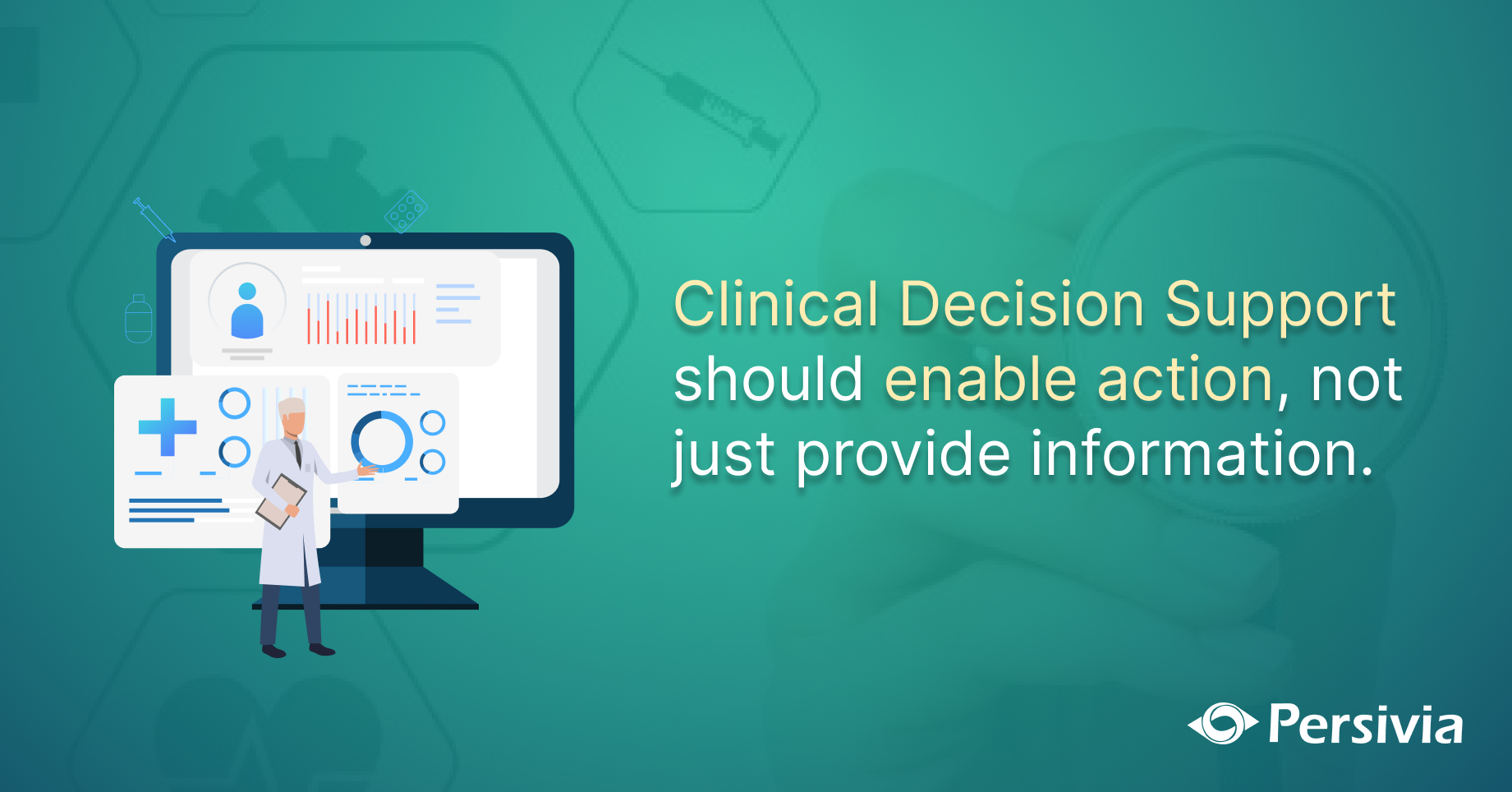Clinical decision support CDS systems have mastered the art of generating insights but failed at the science of enabling action. Despite decades of advancement in healthcare technology, we’re still stuck with tools that tell clinicians what needs to be done but leave them to figure out how actually to do it across multiple disconnected systems.
Clinicians don’t want more data; they want fewer decisions. Yet healthcare technology continues to confuse complexity with sophistication, assuming that because clinicians are intelligent, they must want more dashboards, more alerts, more choices. What they need is something that no algorithm can measure, i.e., cognitive relief.
This fundamental disconnect between intelligence and action represents more than just a workflow inefficiency. It’s a barrier to better patient care. When clinical decision support tools require clinicians to step outside their primary workflow to act on recommendations, those insights often go unaddressed or get delayed. The evolution from insights to action isn’t just another technological upgrade; it’s reshaping how we think about clinical decision support entirely.
The Problem with Read-Only Clinical Decision Support CDS
The fundamental issue with most clinical decision support CDS systems isn’t the number of alerts; it’s the hidden cost of each micro-decision. Every time we ask a clinician to interpret another data stream and then figure out how to act on it across different systems, we’re not helping them; we’re taxing them cognitively.
Information isn’t valuable; clarity is. When clinicians receive an alert about a care gap or medication adherence issue, they don’t just need to know about the problem; they need a clear path to resolution. Clinical Decision Support CDS creates what we call “open loops,” providing insights but leaving the execution to manual processes across multiple systems.
This creates an enormous mental burden. Clinicians end up maintaining running to-do lists in their heads while jumping between different applications. We’re talking about 2-3 minutes lost per actionable alert due to system switching, but the real cost is the cognitive load of managing incomplete workflows. The best clinical decision support doesn’t make clinicians feel smarter; it makes them feel confident and more focused on patient care.
The Write-Back Revolution
Write-back capability solves this by closing the loop between insight and action. When you can act on clinical decision support recommendations right where you found them, without switching systems or re-entering information, everything changes. The real benefit isn’t just time savings. It’s about maintaining clinical focus and enabling evidence-based care to happen naturally within existing workflows.
When clinical decision support can both read from and write to the EHR, several game-changing benefits emerge. Real-time information exchange means patient data stays synchronized across all connected systems instantly. Safety alerts become actionable immediately instead of creating mental reminders for later action. Care coordination improves when all team members can see what actions have been taken as they happen.
Medication adherence alerts that can trigger immediate prescription renewals, patient outreach, and care plan updates, all from the same screen where the alert appeared. Or sepsis protocols that don’t just identify at-risk patients but immediately enable the right order sets, notify care teams, and trigger escalation procedures. This seamless integration transforms potentially disruptive alerts into workflow-enhancing tools.
CareTrak®: Truly Actionable Clinical Decision Support CDS
At Persivia, we’ve built our CareTrak® platform around this fundamental principle: clinical decision support should enable action, not just provide information. Our bidirectional data exchange with over 80 EHR systems allows clinicians to view insights and take action without the typical workflow disruption that plagues CDS implementations. What makes this approach particularly effective is native workflow embedding. CDS functionality appears as natural EHR features rather than external applications requiring separate navigation.
CareTrak®’s write-back capabilities enable clinicians to capture HCC codes, close care gaps, and update care plans all within the same screen where insights appear. This integration extends across web and desktop platforms, ensuring a consistent user experience regardless of how different providers prefer to access clinical information. Rather than adding another layer for clinicians to manage, our platform becomes part of how healthcare providers naturally work, ensuring that clinical decision support insights lead to immediate, effortless action.
The Path Forward
The healthcare industry is at a crossroads. Organizations that keep relying on read-only CDS tools are going to find themselves at a severe disadvantage in an environment where cognitive relief, not cognitive overload, drives adoption and effectiveness.
The question for healthcare technology builders isn’t “what more can we show?” but rather “what decisions can we take away?” Write-back capability represents this philosophy in action.
It reduces the decision burden on clinicians by enabling immediate resolution of insights without workflow disruption. When insights seamlessly turn into actions, clinicians can focus on patient care.
The technology is here today, the benefits are proven by organizations that have already made the switch, and the competitive advantage is clear. Looking ahead, the most effective clinical decision support will be the kind that removes complexity rather than adding to it. Tools that help clinicians feel calmer and clearer, not overwhelmed by information they can’t immediately act upon.
The bottom line hasn’t changed; in clinical decision support, insights alone aren’t enough. Action wins, but simplicity and cognitive relief win even more.
Ready to see write-back clinical decision support CDS in action?
Book a demo to see how CareTrak®’s bidirectional connectivity streamlines clinical workflows, and empowers clinicians to access insights and take action directly within their EHR.
Table of Contents
